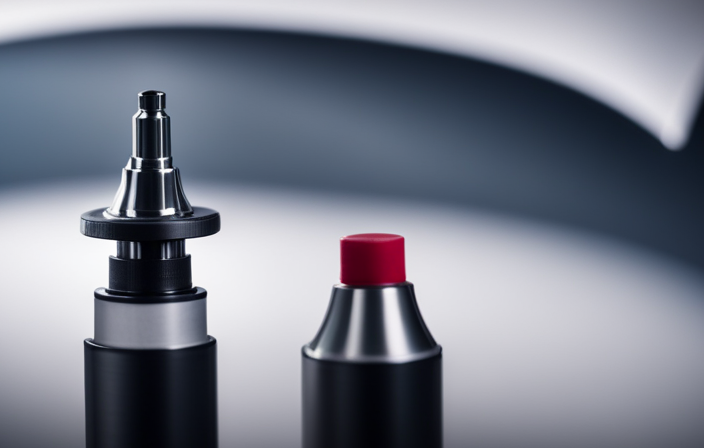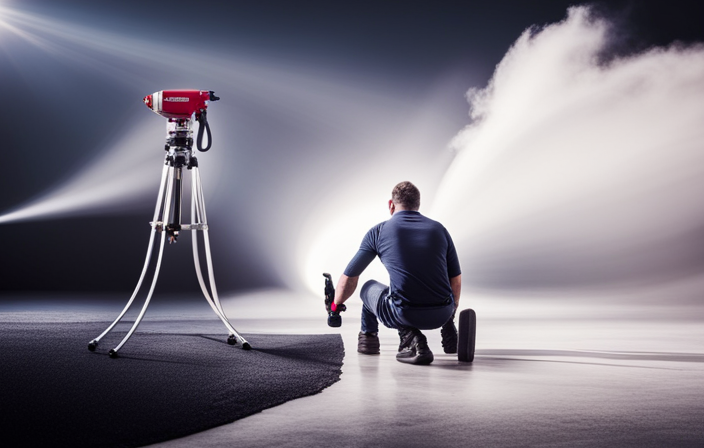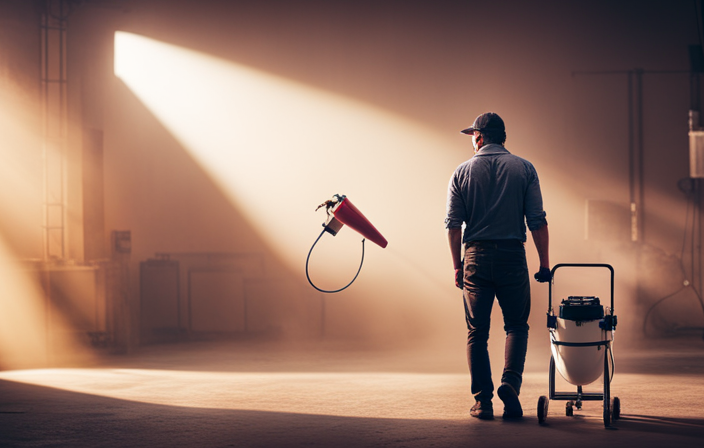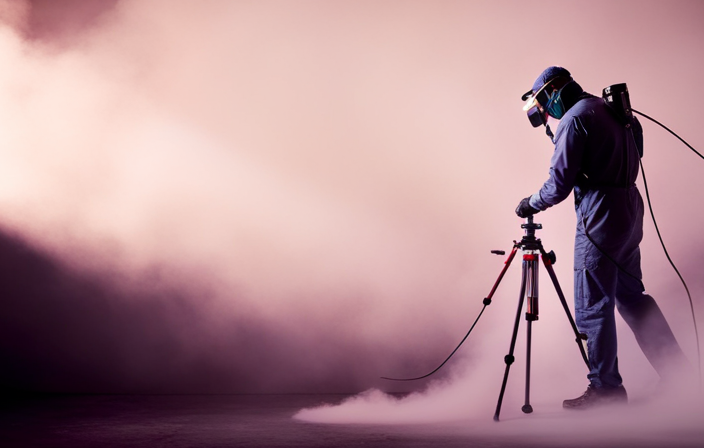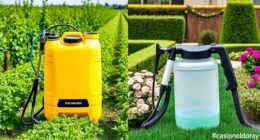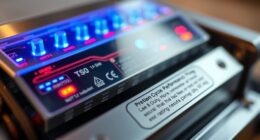Tired of spending hours painting with a brush or roller only to see streaks and uneven coats? I have the ideal solution you’ve been searching for! Choosing the right tip size for your airless paint sprayer is crucial for achieving a flawless result. With years of experience in the painting industry, I have learned valuable tricks to guarantee a job well executed.
In this article, I’m going to share my expert knowledge on the best tip number to use for your airless paint sprayer. We’ll delve into the different types of tips, factors to consider when choosing a tip number, and even some specialty techniques for those unique painting projects. So, if you’re ready to take your painting skills to the next level, let’s dive in and discover the secret to achieving professional-quality results every time.
Key Takeaways
- Regular cleaning and maintenance are important for optimal performance of an airless paint sprayer.
- Choosing the right tip size based on the desired finish and paint viscosity is crucial.
- Following the manufacturer’s guidelines for cleaning and maintenance is essential.
- Seeking expert recommendations and understanding painting needs can help determine the best tip number to use.
Understanding Tip Numbers for Airless Paint Sprayers
If you want to achieve the perfect paint finish with your airless paint sprayer, you need to understand the tip numbers and how they can impact your project.
Choosing the right tip size is crucial for achieving the desired spray pattern and overall quality of your paint job. The tip number refers to the orifice size, which determines the amount of paint that is sprayed onto the surface.
A smaller tip number, such as a 415, will create a narrow spray pattern ideal for fine details and precision work. On the other hand, a larger tip number, like a 619, will produce a wider spray pattern, perfect for covering large areas quickly.
Understanding spray pattern is essential for achieving even coverage and avoiding streaks or blotches.
Now, let’s delve into the different types of tips and their uses.
Different Types of Tips and Their Uses
When it comes to airless paint sprayers, understanding the different types of tips and their uses can greatly enhance your painting experience.
Different tip sizes are available for airless paint sprayers, and each size is designed for specific applications. Smaller tip sizes, such as 0.009 or 0.011, are ideal for fine finishes and detailed work. They produce a narrow spray pattern, allowing for precise control and less overspray.
On the other hand, larger tip sizes like 0.015 or 0.017 are better suited for larger surfaces and thicker materials. They deliver a wider spray pattern, which covers more area in less time.
Knowing the recommended applications for each tip size will help you achieve professional results.
Now, let’s dive into the factors to consider when choosing a tip number for your airless paint sprayer.
Factors to Consider When Choosing a Tip Number
One key factor to consider when selecting a tip size is the specific application you have in mind. Factors to consider when choosing the right tip number include the type of material you will be spraying, the desired finish, and the size of the surface area. To help you make an informed decision, here is a table outlining the recommended tip sizes for different applications:
| Material | Finish | Surface Area | Recommended Tip Size |
|---|---|---|---|
| Latex Paint | Fine | Small to Medium | 211 or 311 |
| Lacquers | Smooth | Small to Medium | 309 or 409 |
| Stains | Even Coat | Small to Medium | 311 or 411 |
| Heavy Coatings | Coarse | Medium to Large | 515 or 615 |
| High-Viscosity Materials | Texture | Large | 619 or 819 |
Considering these factors and using the appropriate tip number will ensure optimal results. In the next section, we will explore common tip numbers and their applications.
Common Tip Numbers and Their Applications
The world of painting opens up with a myriad of tip sizes, each with its own unique application and ability to transform surfaces into works of art. When it comes to airless paint sprayer maintenance, choosing the right spray tip is crucial for achieving desired results.
Common tip numbers like 515, 517, and 519 are widely used for various projects. The 515 tip is great for general purpose spraying, providing a balance between coverage and control. For thicker materials or larger surfaces, the 517 tip is ideal as it delivers a wider spray pattern. If you’re looking for even more coverage, the 519 tip is a popular choice.
It’s important to consider the type of paint, surface, and desired finish when selecting a tip number. By choosing the right tip, you can achieve professional-looking results with your airless paint sprayer.
Now, let’s dive into the subsequent section about fine finishing tips for smooth and even results.
Fine Finishing Tips for Smooth and Even Results
Achieve flawless, professional-grade results with your painting projects by utilizing these expert tips for achieving a smooth and even finish. When it comes to fine finishing with an airless paint sprayer, the spray pattern and tip size are crucial factors to consider.
To ensure a smooth and even application, here are two essential sub-lists to keep in mind:
-
Choose the right spray pattern: Opt for a narrow spray pattern tip, such as a 6-inch fan, for detailed work and intricate surfaces. This will allow you to have better control and precision, resulting in a more refined finish.
-
Select the appropriate tip size: For fine finishing, a smaller tip size, like a 0.011 or 0.013, is recommended. This will produce a finer mist, preventing overspray and providing a smoother coat of paint.
By paying attention to the spray pattern and tip size, you can achieve exceptional results with your airless paint sprayer.
Now, let’s move on to wide fan tips for quick coverage on large surfaces.
Wide Fan Tips for Quick Coverage on Large Surfaces
Get ready to effortlessly cover large surfaces with quick and even results by using wide fan tips when painting. Wide fan tips are perfect for providing maximum coverage on large areas, allowing you to save time and energy.
These tips create a wide spray pattern that evenly distributes the paint, ensuring a smooth finish every time. When using wide fan tips, it’s important to maintain a consistent distance from the surface to ensure uniform coverage. By moving the sprayer in a steady, overlapping motion, you can achieve a professional-looking finish in no time.
However, if you’re looking to achieve more intricate or detailed work, specialty tips for unique painting techniques may be necessary.
Transitioning into the next section, let’s explore the various options available for these specialty tips.
Specialty Tips for Unique Painting Techniques
Explore the exciting world of unique painting techniques with specialty tips that add an artistic touch to your surfaces. These specialty tips are designed to create unique spray patterns, allowing you to achieve stunning effects on your walls, furniture, or any other surface you’re painting.
Whether you want to create a textured look, a faux finish, or a delicate stencil design, these specialty tips are your go-to tools for advanced paint application techniques.
Here are three specialty tips that can take your painting skills to the next level:
-
Fan Pattern Tip: This tip creates a wide, fan-shaped spray pattern, perfect for creating smooth, even coats on large surfaces.
-
Detailing Tip: This tip is ideal for intricate designs and small areas that require precision. It allows you to control the paint flow and create fine lines with ease.
-
Texturing Tip: If you want to add depth and texture to your surfaces, this tip is perfect. It creates a textured finish, giving your walls or furniture a unique and artistic look.
With these specialty tips, you can unleash your creativity and achieve professional-looking results.
Now, let’s dive into the next section and learn about adjusting sprayer settings for optimal performance.
Adjusting Sprayer Settings for Optimal Performance
Enhancing your painting experience begins by fine-tuning the settings on your sprayer for optimal performance. Adjusting the pressure on your airless paint sprayer is crucial to achieve the desired results. Too high of a pressure can lead to overspray and an uneven coat, while too low of a pressure can result in a poor finish. Start by setting the pressure at a medium level and make adjustments as needed.
Additionally, troubleshooting tips can help you address common issues. If you notice uneven spray patterns or clogs, check the tip size and make sure it’s appropriate for the paint you’re using. Clean the tip regularly to prevent buildup.
Proper maintenance and cleaning of your airless paint sprayer are essential for its longevity and continued performance. Transitioning into the next section about tips for proper maintenance and cleaning, it’s important to keep your sprayer in top condition to ensure consistent and reliable results.
Tips for Proper Maintenance and Cleaning
When it comes to getting optimal performance from your airless paint sprayer, adjusting the sprayer settings is just one piece of the puzzle. Proper maintenance and cleaning are equally important to ensure that your sprayer continues to work efficiently and produce high-quality results.
To maintain your airless paint sprayer, it’s essential to regularly clean the equipment after each use. This involves flushing out any remaining paint and residue from the sprayer, as well as cleaning the filters and nozzles. Additionally, using the right cleaning solutions is crucial to prevent clogging and buildup.
When it comes to maintenance techniques, it’s recommended to follow the manufacturer’s guidelines and recommendations. This will help prolong the lifespan of your sprayer and prevent any potential issues down the line. By investing time and effort into proper maintenance and cleaning, you can ensure that your airless paint sprayer continues to perform at its best.
Now, let’s dive into expert recommendations for the best tip number to use with your airless paint sprayer.
Expert Recommendations for the Best Tip Number
For optimal results with your airless paint sprayer, experts recommend considering the ideal size of the nozzle for your specific painting needs. Understanding tip sizes and selecting the right tip for the job is crucial in achieving professional-quality results.
The tip number refers to the size of the orifice, which determines the amount of paint that is sprayed onto the surface. A smaller tip number, such as a 415 or 515, is suitable for fine finishes and detailed work, while a larger tip number, like a 619 or 721, is better for larger surfaces and thicker coatings.
It’s important to choose a tip size that matches the viscosity of the paint you’re using. Using the correct tip size ensures an even and consistent spray pattern, minimizing overspray and maximizing efficiency.
So, when it comes to selecting the best tip number for your airless paint sprayer, it’s essential to understand your painting needs and choose accordingly.
Frequently Asked Questions
Can I use the same tip number for all types of paint?
Yes, using different tip sizes for different types of paint is recommended. It allows for better control and coverage. The pros include improved precision and reduced overspray. However, the cons are the need for multiple tips and the potential for clogging.
Are there any safety precautions I should take when using an airless paint sprayer?
When using an airless paint sprayer, it is crucial to take certain safety precautions. Always wear protective gear such as goggles, gloves, and a respirator. Ensure proper ventilation and be cautious of high-pressure spray.
How do I know if I need a fine finishing tip or a wide fan tip?
To determine the ideal tip size for different painting needs, consider the desired finish and the type of material being sprayed. A fine finishing tip is best for smooth surfaces, while a wide fan tip is suitable for covering large areas quickly.
Can I use my airless paint sprayer for other projects besides painting walls?
Yes, you can definitely use an airless paint sprayer for projects other than painting walls. I have used mine for furniture refinishing and outdoor projects like staining decks and fences. It’s a versatile tool!
How often should I clean my airless paint sprayer?
Maintaining an airless paint sprayer is crucial for optimal performance. Regular cleaning is key to prevent clogs and ensure smooth operation. Troubleshoot common issues by checking filters, valves, and pressure settings. Stay tuned for more tips and tricks!
Conclusion
In conclusion, choosing the right tip number for your airless paint sprayer is crucial for achieving the best results. By understanding the different types of tips and their uses, considering factors like paint viscosity and desired coverage, and following expert recommendations, you can ensure optimal performance and a professional finish.
So, why settle for anything less than perfection when it comes to your painting projects? Isn’t it time to take your skills to the next level by using the best tip number for your airless paint sprayer?
